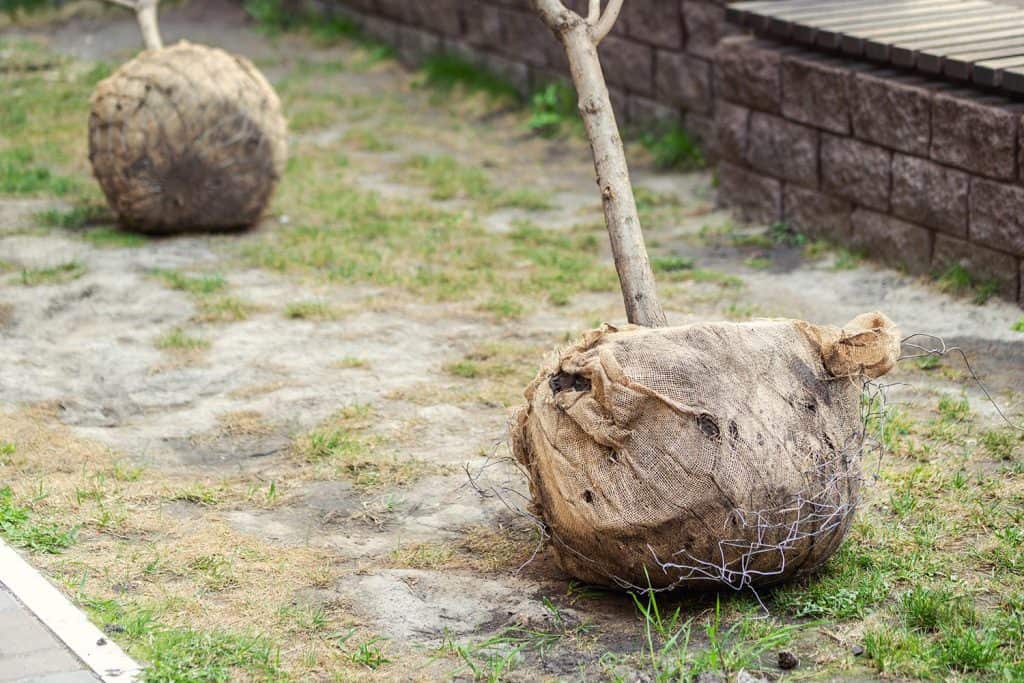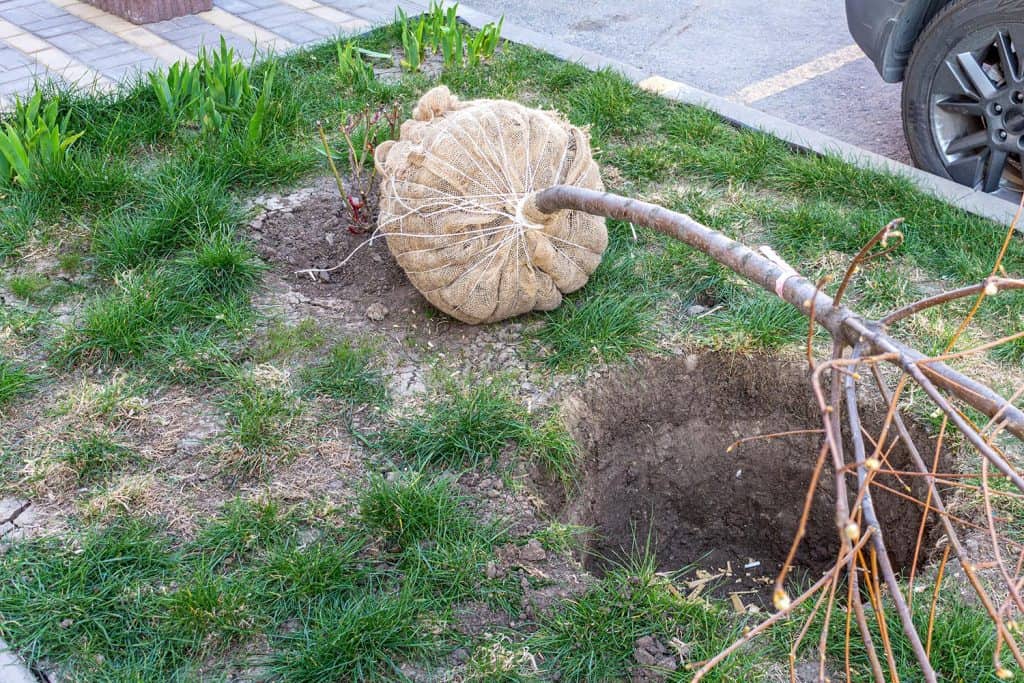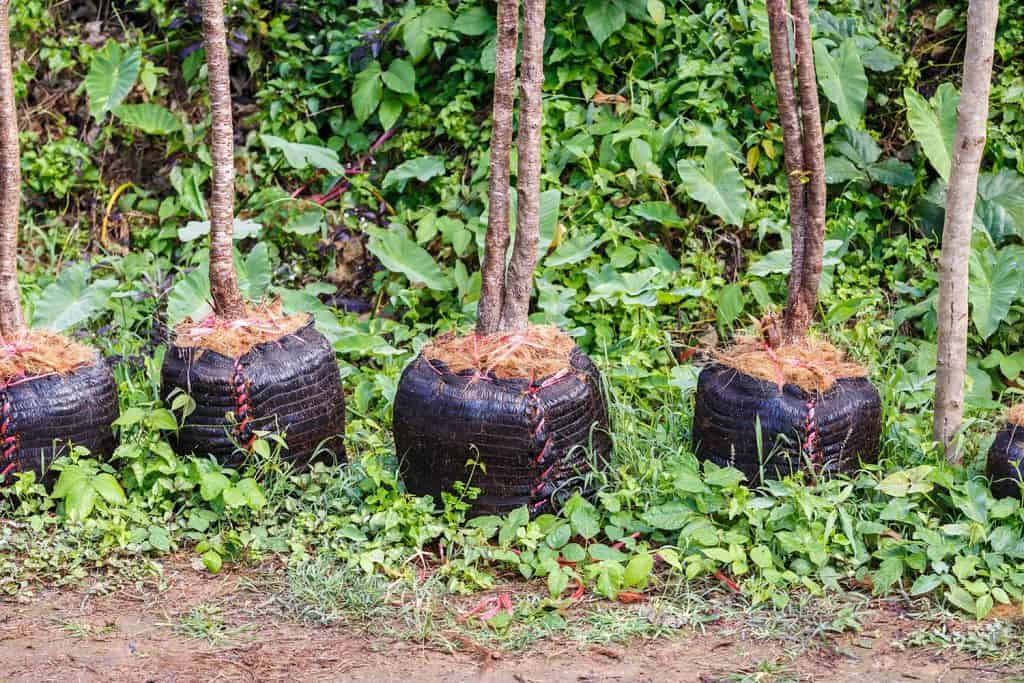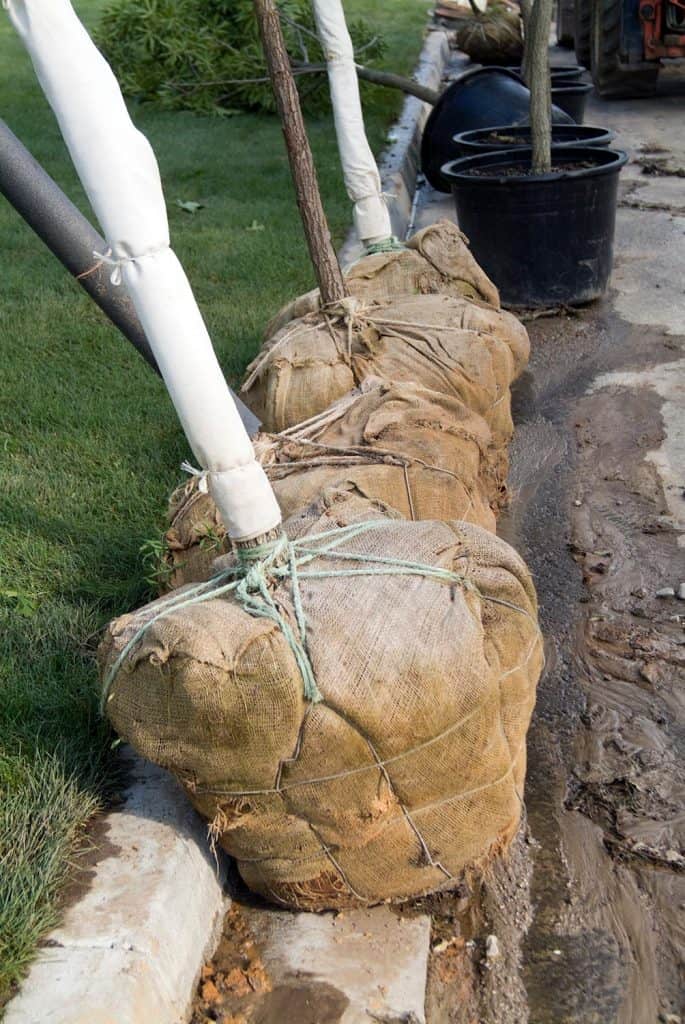Are you adding new trees to your landscape? Or, maybe you are moving trees that you currently have. Balled and burlapped is a process used to transplant trees and shrubs that had been previously planted and experienced growth. You may be wondering how to care, move properly, and transplant these balled and burlapped items. We researched all about moving balled and burlapped trees and will share the answer with you.
Balled and burlapped trees are heavy. To move these trees, you will need a large vehicle, like a truck or trailer. Slide them in and out of their transportation using a ramp. Moving the tree to the planting site can be done using a wheelbarrow or heavy-duty cart.
Moving a tree should always be done with care. Continue reading as we provide more tips on moving your balled and burlapped trees and answer how long a tree can stay burlapped before planting.

How To Move A Balled And Burlapped Tree
The weight of a balled and burlapped tree is not something that can be moved around alone. You can expect the tree to weigh somewhere between 300-500 pounds. Recruit the help of 2-4 people when getting ready to transport your trees.
With every step of moving a balled and burlapped tree, you should apply care and patience. Moving the tree carefully will ultimately leave you with healthy, undamaged roots, branches, and leaves. Let's break down the details of moving these large balled and burlapped trees.
Vehicles And Protection
Due to the size and weight of these trees, they cannot be supported by the suspension of a car. You will need a truck or trailer big enough to hold your tree without damaging any branches. You can often find rental vehicles for this job that are relatively inexpensive.
Protecting the tree during the transportation is necessary by using tie-downs and covers, and use a mesh tarp to cover the branches and leaves of your tree. Tie-downs can be used to stabilize the tree to avoid the trunk or major branches breaking off in transit.
You can find a mesh tarp here on Amazon.
From The Vehicle, To The Ground

Getting the tree from the vehicle to the ground is the next big feat. Getting your vehicle as close to the planting site as possible is ideal, but unfortunately, this is not always possible.
If you have a long way to transport your balled and burlapped tree, use a wheelbarrow to a large cart to transport it safely. When moving the tree, do not drop it into place. Instead, slide it. This will protect the roots.
How Do You Transport A Tree From A Pickup Truck?
If you have a balled and burlapped tree in the back of your pickup truck, you are probably wondering how to get it out. Remember, sliding is better than dropping. Avoid dropping the tree off the tailgate of your pickup, as this can damage the root ball of your tree.

Instead of dropping, create a ramp using a thick plank. Slowly slide your tree down the ramp with the help of a couple of other people. Remember, the weight of these trees requires some assistance for safe movement.

Damage to the root ball can be detrimental to your tree. This is why extreme care in transit is recommended. A damaged root ball causes stress to your tree, which can make it more susceptible to pests and other diseases. These conditions can ultimately lead to the death of your tree.
Learn more on our blog post, “How Much Does A Balled And Burlapped Tree Weigh? [By Tree Type And Size]”
How Long Can A Tree Stay In Burlap Before Planting?
Are you not ready to plant your trees quiet yet? Don't worry; trees can stay burlapped for longer than you may think. Balled and burlapped trees can be stored for weeks or even months with the proper care.

If you plan to postpone planting for a bit, place your tree in a shady area and keep the roots moist. Keeping the roots from drying out is of utmost importance. Sufficient watering helps to stay on top of this. You can also apply damp paper to the tree roots to aid in moisture for longer periods.
Storing for more extended periods may require a little more effort. Temporarily heeling the root ball into a bed of soil or sawdust can be done for up to two months. This is the limit for stored balled and burlapped trees, as the burlap will begin to break down or deteriorate at this stage.

Read more on our blog post, “15 Fruit And Nut Trees For Zone 6.”
How Big Of A Tree/Shrub Can You Transplant By Hand?
Many trees and shrubs can be transplanted by hand within some size limits. If you are ever concerned or unsure about transplanting a tree, consult a professional to gain insights and advice.
Trees that are 2 inches (ca. 5 cm) in diameter are typically easy and safe to transplant on your own. Trees with a diameter of over 2 inches can become more difficult, but it is not impossible. Any tree or shrub with a diameter of over 4 inches (ca. 10 cm) should be done with the help of a professional.
The video below shows you the steps to transplanting a tree by hand:
When transplanting a tree, the hole it is going into needs to be at least 2-3 times the size of the root ball. If you have to dig a grand-sized hole, this can help you determine if the transplanting can be done manually or if you'll need the help of a machine.
Read more on our blog post, “11 Gorgeous Trees That Like Wet Soil And Shade.”
How Do You Dig, Ball, And Burlap Trees?
Digging up a tree with its root ball and wrapping it in burlap is not always an easy job. This is primarily due to the physical effort needed for the digging and the movement of the weight. If you are up for the challenge, follow these steps:
- Scrape vegetation away from around the tree
- Determine the size of the root ball (~11 inches per 1 inch of tree caliper)
- Use a spade to dig a shallow trench around the tree to outline the top of your ball
- Gradually dig the trench wider and deeper, sculpting a ball shape
- Start carving under the ball as you go deeper
- At about 75% down the size of the ball, you can start forcing the spade under the ball at an angle
- Once your ball is loose, gently lift the ball out of the hole and place it on your burlap
- Pull the opposite corners of your burlap together and tie as tight as possible
- Use pinning nails to close loose areas of your burlap
- Once have a balled and burlapped tree, then get it into a wheelbarrow or cart for transportation
Have a look at this roll of burlap here on Amazon.
This video shows you a great visual on how to dig, ball and burlap a tree with some additional tips and tricks.
Have patience when digging out your root ball—the less damage to the roots, the better for transplanting and decreasing stress on your tree. Ensure you use a sharp spade when digging under your root ball. The sharp spade allows a clean cut through your roots. Using a dull spade can cause further damage to your root ball.
Find a steel-handled garden spade here on Amazon.
If you plan to have your balled and burlapped tree out of the ground for some time, give your root ball a thorough watering. Keeping your roots moist will keep your tree happy until it is ready to go back into the ground.
In Closing
Moving a balled and burlapped tree should be done carefully and with help. When in transit, you want to take the appropriate measures to protect your tree from any added damage. The use of mesh tarps and tie-downs can help with this. Avoid dropping a balled and burlapped tree. Instead of dropping it off your vehicle, use the sliding method.
We hope you found this article helpful for transporting your balled and burlapped trees. Maybe you even found some valuable tips for digging, balling, and applying burlap to trees on your current landscape.
Are you seeking knowledge on tree removal? Have a look at our blog post, “How To Remove A Tree From Your Yard? [5 Crucial Things To Consider].”



